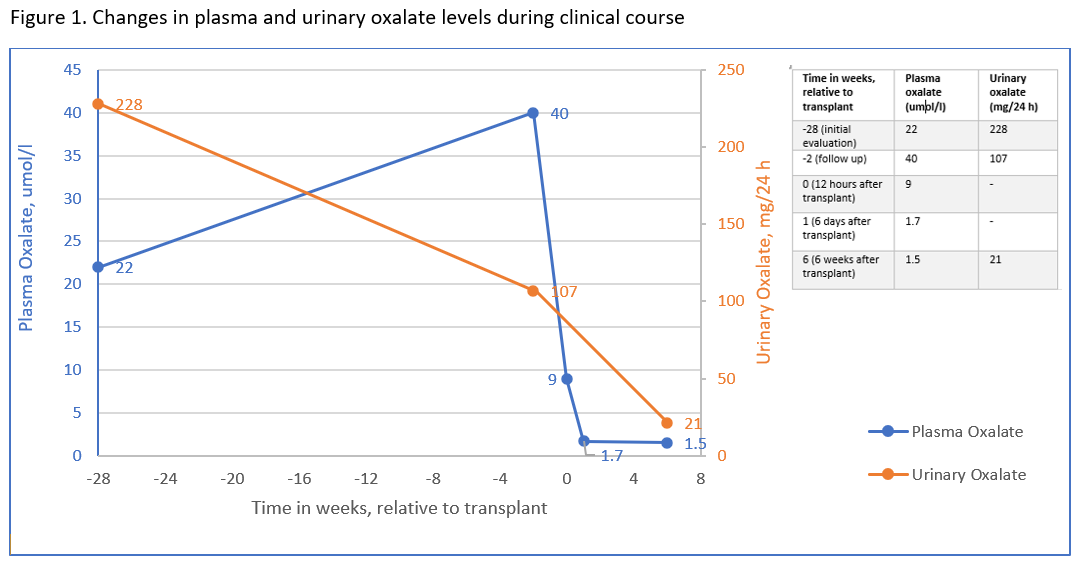Correction of Hyperoxaluria in a Primary Hyperoxaluria Type 2 Patient After Simultaneous Liver Kidney Transplantation
Nephrology and Hypertension, Mayo Clinic, Rochester, MN
Meeting: 2022 American Transplant Congress
Abstract number: 1077
Keywords: Kidney/liver transplantation
Topic: Clinical Science » Liver » 52 - Liver: Kidney Issues in Liver Transplantation
Session Information
Session Name: Liver: Kidney Issues in Liver Transplantation
Session Type: Poster Abstract
Date: Sunday, June 5, 2022
Session Time: 7:00pm-8:00pm
 Presentation Time: 7:00pm-8:00pm
Presentation Time: 7:00pm-8:00pm
Location: Hynes Halls C & D
*Purpose: To demonstrate the role of simultaneous liver kidney transplant in PH2
*Methods: A 30-year-old white man presented to our center for evaluation of chronic kidney disease stage 4 secondary to primary hyperoxaluria type 2 (PH2). He had recurrent episodes of urolithiasis after age 18 yrs requiring 4 lithotripsy procedures, but a diagnosis of PH2 was not made until genetic testing at age 28 yrs identified two pathogenic variants in the glyoxylate reductase hydroxypyruvate reductase (GRHPR) gene [c.103delG (p.Asp35Thrfs*11); c.781_782delinsTAC (p.Gly261Tyrfs*2)]. His initial serum creatinine (SCr) at our center was 4.71 mg/dl (eGFR 18 ml/min/1.73 m2) with plasma oxalate (POx) of 21.9 µmol/l [normal <2] and urinary oxalate (UOx) of 228 mg/24 h [normal <41]. Urinary glycerate was markedly elevated at 197 mg/g Cr [normal < 25], consistent with PH2. Medications included potassium citrate, magnesium oxide and chlorthalidone. His kidney function progressively declined over the next 5 months at which time SCr was 8.79 mg/dl (eGFR 8 ml/min/1.73m2) and POx 28.8 µmol/l. Given the marked degree of hyperoxaluria and potential for recurrent oxalate nephropathy the patient underwent evaluation for simultaneous liver kidney (SLK) transplant, which he subsequently received 6 weeks after activation on the waiting list without ever requiring renal replacement therapy.
*Results: Both allografts had good initial function and the patient did not require post-surgical hemodialysis. POx fell from 39.6 preoperatively to 9.1 µmol/l 12 hours posttransplant, and then 6.8 µmol/l 36 hours later. POx remained <3 µmol/l through the most recent follow up 6 weeks after transplant. Correspondingly UOx decreased to 21 mg/24 h by 5 weeks after transplant and urinary glycerate normalized to 3 mg/g. SCr ranged between 1.86-2.01 mg/dl (eGFR 48-55 ml/min/1.73 m2) once stabilized after discharge. His postoperative course was complicated by recurrent ascites; transjugular hepatic venogram revealed mild narrowing of the intrahepatic inferior vena cava which has been managed conservatively to date.
*Conclusions: This case, together with 2 others in the literature, provides further evidence regarding SLK transplantation in PH2. Even though GRHPR has a wide tissue distribution, evidence suggests it is predominantly expressed in the liver, and as a group these 3 cases suggest liver transplantation can reduce oxalate generation to normal (non-PH2) levels. Thus, SLK transplant is a viable therapeutic option for select PH2 patients with advanced CKD.
To cite this abstract in AMA style:
Genena K, Milliner D, Lieske J. Correction of Hyperoxaluria in a Primary Hyperoxaluria Type 2 Patient After Simultaneous Liver Kidney Transplantation [abstract]. Am J Transplant. 2022; 22 (suppl 3). https://atcmeetingabstracts.com/abstract/correction-of-hyperoxaluria-in-a-primary-hyperoxaluria-type-2-patient-after-simultaneous-liver-kidney-transplantation/. Accessed December 15, 2025.« Back to 2022 American Transplant Congress

